
Visual Concepts is probably most well known for the Dreamcast’s excellent 2K sports series but towards the end of the Dreamcast’s lifespan, they went off in an entirely new, non-sports-related direction. Floigan Bros. and Ooga Booga were released in late 2001 and slipped under the radar for a lot of gamers who were moving on to other consoles. This doesn’t mean they were bad games by any stretch of the imagination, they just had bad timing. In fact, these two games are some of my favorites on the system. They both have an entirely unique style and concept (pardon the pun) that I have yet to see in any other games to this day. To me, they represent the main reason I love the Dreamcast so much: the quirky, fun, and unique library of games. Sega wasn’t afraid to try something new which is a rarity in today’s market where every other game is a cookie-cutter first-person shooter. Not that there’s anything wrong with a good first-person shooter but what happened to the creativity and inspiration to try something new and different? Maybe that will return some day but for now we at least have games like Ooga Booga to fall back on when we get bored of no-scoping 9-year-olds.
So what went on in the minds of the folks that created Ooga Booga? How did they come up with this plumb crazy, boar-filled, tropical themed, genre-defying game? Let’s have a chat with the game’s producer, John Race, and find out!
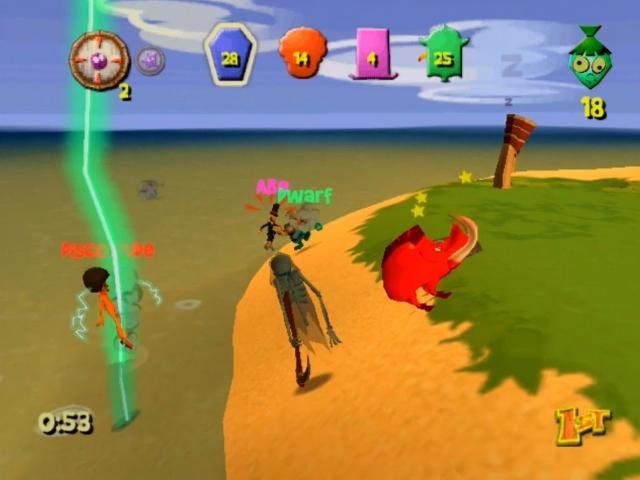
Q: Before we get started I just want to thank you for being gracious enough to be interviewed about a now 16-year-old game. It’s an unusual request I’m sure. Let’s start off with the beginnings of Ooga Booga. Can you give us some history on how you got the idea for the game? Was the initial concept any different than the final product?
“I think the real genesis was that Sega really wanted to show off the online capabilities of the Dreamcast.They wanted to create an online, multiplayer game that could be done fairly quickly for the platform.And really that was kind of the box they asked us to fill.And sometimes not having any constraints can be way harder creatively than having someone tell you to build a specific genre of game based on a license. Actually, I’d say it’s always harder. The team that we had was mostly made up of people from Berkeley Systems who were brought in together as that studio was shutting down. Andrew Leker was the guy who initially got hired and brought everybody in and he was a big strategy game guy, and so was I. So initially we had this idea to do a console-friendly real time strategy game with online multiplayer. We actually built some rapid prototypes that had almost nothing in common with where we ended up. The initial versions all had a much bigger scale, where the player avatar was like a guy on a horse or wolf or something and was much smaller on screen, covering a much larger geographical area. There were concepts around converting villages, which would give you power that you could use to cast spells. The one thing that was there pretty much from the start was casting spells and terrain deformation. And I was going to say that the initial versions were totally different but as I’m answering I’m realizing that a lot of the core mechanical ideas were kind of there. I think the big difference was that there was no real sense of the setting. A lot of the earliest thinking was about a Middle Eastern setting and taming genies or djinni. But it never really felt like we had a direction until we started to explore the tiki theme. Suddenly it made sense to bring the scale way down and get closer to the avatars and that let us do more with character animation and the setting. That’s when things really started to come to life.”
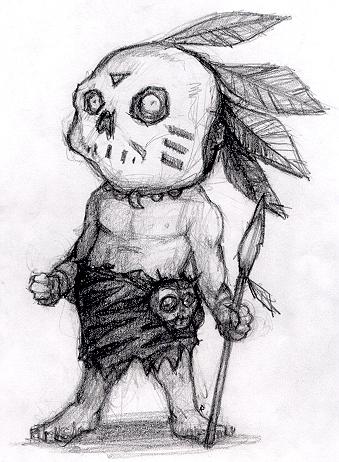
Q: What can you tell me about the development of the game? Were there any particular challenges you faced? I know with Floigan Bros., you had to develop an entirely new game engine from the ground up. Was the same true of Ooga Booga?
“As I said, there was a lot of flailing around on the fiction and setting and to some degree the game play. There were definitely lots of times where I think we all were kind of like, “what the hell are we doing?” That was certainly true for me. I think Ken Levine said something which I’m going to butcher here, but basically the idea that every time he starts a new game it feels like he has forgotten everything he knew about how to make games in general. And for most of the team, this was our first relatively big game for a major console, so we didn’t even have the experience to know that feeling like nothing is working kind of comes with the territory when you’re working on an original design. So we fought that feeling pretty regularly, especially before we finally got to the tiki wrapper. And being inside Visual Concepts only made that harder in some ways. Not that they weren’t supportive, they were incredible. But that is such a smart studio and it’s so filled with rocket scientists that for me at least, I’d somehow managed to sneak in there and it was only a matter of time until they figured out they’d hired a fraud.
As far as tech challenges, there were plenty. Nate or Evan could correct me but I think we built that game on their sports engine. As you can imagine it was not really designed for what we were trying to do, so we had to develop tons of work arounds. Also, we were trying to do any combination of 1 to 4 players either networked or local, and I’m pretty sure no one had done that at that point. So that was pretty crazy. Andrew Leker had the idea that we would use a synchronized lock step networking model, which meant that all of the results for all of the player’s machines were playing back the exact same thing at the exact same time. It essentially turned one of the Dreamcasts into the server that did the actual world state calculations based on input and which then sent the updates on the new world state to all the other machines. And that was crazy challenging. Because all of the machines used the same pre-generated random numbers for all of their random numbers. I remember that in the early days, you’d get these conditions where one machine would advance one more random number entry than the other machines and at that point it would slowly drift off into its own reality. One final thing we did that was totally bonkers, was, if you kept everyone synchronized, it meant that there was a ton of lag potentially if someone had a bad connection. And even on decent 56k modem connections, it wasn’t great. So somebody on the dev team had the idea to let the local input for joystick control of the player avatar occur in real time. In other words if you pushed right on the stick, your little guy would immediately start moving right on your machine without waiting on the network. It would also report your movement input to the other Dreamcast running the server, which would then adjust the world state and send back the update to all the players. And if in the mean time you had zigged left, when the update came, you’d be warped back into your “correct” world state position. But because the game was so kinetic with stuff bouncing all over the place, most of the time you didn’t really notice it. So it felt like a local couch coop game because as soon as you gave input you got a result on screen. It made it feel unbelievably responsive, but it only worked because of the cartoony, bouncy nature of the game play.”
Q: How long was the game in development overall? Did it take any longer than expected?
“I can’t remember the exact dates but the whole thing was slightly less than a year and half I think. Right around there. We felt a tremendous pressure to get the thing done because the Dreamcast was in danger of entering the end of its lifespan. EA had already announced that it wouldn’t support the DC anymore and one of the objectives of greenlighting the project was to show how great the online play could be on Dreamcast. And the further we got into development, the more the writing was on the wall that the Dreamcast was in its sunset phase. It was kind of bitter sweet when it finally got released to pretty solid reviews but there just weren’t that many people playing anymore. It also didn’t help that it released four days after 9/11. Videogames weren’t exactly top of mind. Still I know a lot of people enjoyed it and we played a ton of it online with fans.”
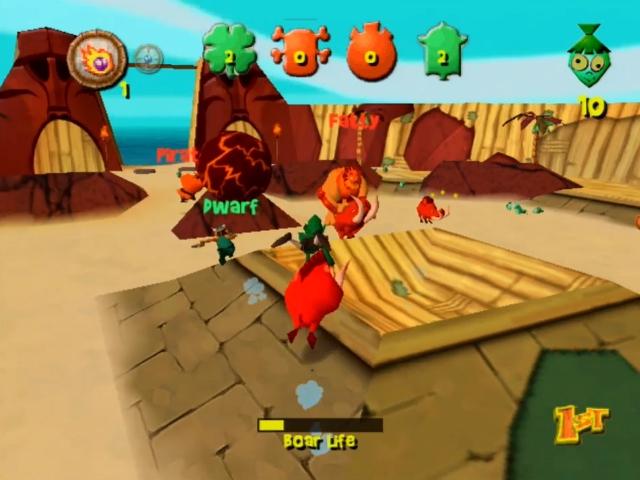
Q: Ooga Booga is certainly a unique and crazy game. How would you describe the game to someone that had never heard of it?
“We really wanted to make something different and I think we succeeded.I guess I’d call it a frantic action strategy game that wanted to capture the same sense of mayhem as Super Smash Bros. A lot of how the game was developed was thinking up a specific system, like birds, or boars, or tiki heads, and then getting that on it’s feet in an early playable form to see what stuck. If it was fun then we’d dig a little deeper to see if there were ways to apply that system in other ways. So we got the boars working and they were super fun and someone threw out the idea of boar soccer and we dropped a ball into the environment and it just worked. We didn’t have a ton of time but fortunately I think we guessed right more often than wrong. I may be misremembering but I don’t think there were a ton of big systems that got cut once we’d settled on the tiki setting. If something didn’t show promise in its earliest incarnation, we’d just drop it and move on. If it did then we’d focus on it to refine it and see if we could use it in other ways.”
Q: How did you come up with some of the characters in the game? Did you just sit around at a table with other members of the team and come up with completely random ideas like Abraham Lincoln and “Disco Dude”? It seems quite clear that you did a complete 180 on the tropical theme when it came to the unlockable characters.
“The unlockable characters were totally an afterthought. It was one of those things that lots of games were doing, and it seemed like it could be fun as a cheap way to add some rewards to the single player, which was pretty sparse. Once we’d decided we could do it, it just had to work with one of the existing Kahuna’s animation data. So Abe Lincoln totally mapped on top of Hottie? Sure, let’s do it. Pirate for Fatty, Leprechaun for Twitchy, etc. And really it was kind of a reward to anyone who cared on the team, to throw in the most ridiculous things we could think of. Our setting and tone was already over the top, so nothing was really off limits. I think I came up with Abe. I also did the voice for him. Doing the alt characters was kind of a treat late in the project because they were low risk additions that we did when the artists had some spare cycles.”
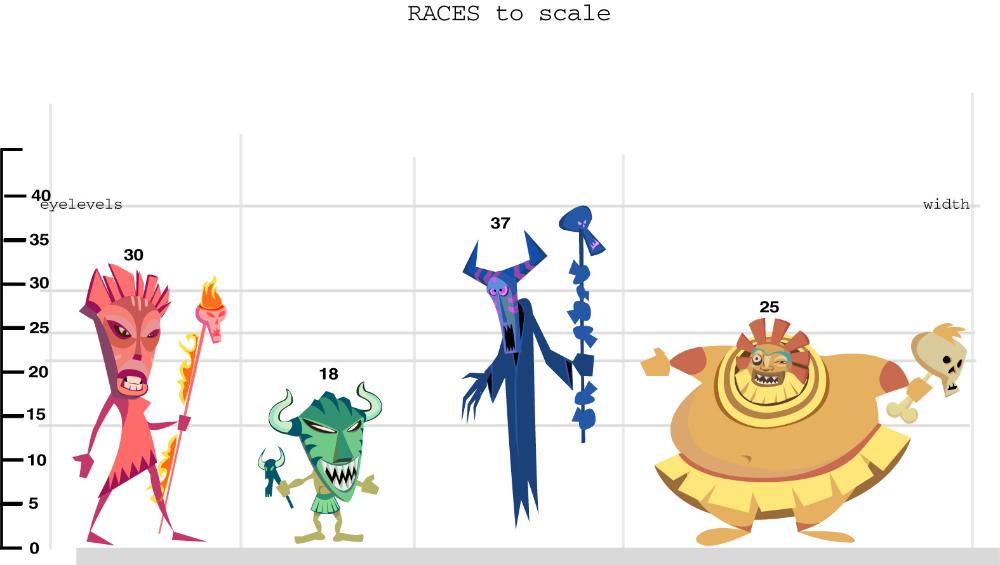
Q: Did Ooga Booga take any inspiration from other games? Floigan Bros. has been referred to as Sega’s answer to Nintendo’s Super Mario Bros.. Was Ooga Booga perhaps the answer to Super Smash Bros?
“Ooga was very much informed by the kinetic nature of Smash Bros. This was partly intentional and partly organic. We all just really, really, REALLY loved Smash. Pretty much every day, for lunch, four or five of us would go to Visual Concept’s game room and for our entire lunch (and sometimes a bit more…) we would play Smash non-stop. We actually ended up in kind of a meta game of our own creation where it was always four player Donkey Kong. I cannot tell you the number of hours that we played four player DK. Almost all on the N64 version. We did play some Gamecube when it came out as well, but the N64 version. That was pure!”
Q: Speaking of Floigan Bros., I’m probably one of the few people to notice the reference to Ooga Booga when Hoigle picks up the native mask and says “This scary mask will make Moigle twitchy with fear!”. It’s always cool to find things like that. Are there any references to Floigan Bros. in Ooga Booga?
“There are not and we probably should have included some. Andy Ashcraft and the Floigan team were right next to us and we were kind of the odd ducks at Visual Concepts since we were (at that time) the two teams working on non-sports content. They were a really cool bunch of guys. Actually everyone at VC was super cool. Now I’m kicking myself for not including them as playable skins!”
Q: Was the game intended from the beginning to have a focus on online multiplayer? It seems Sega was really pushing for developers to implement online functionality into games, especially in later titles like this one.
“Yes, as I said that was a big reason for the whole thing.”
Q: I find the lack of support for the broadband adapter kind of strange, especially since it was such a late release. Was there a reason that was left out?
“I think it was just the aggressive schedule that we had. It could also have been that the executive layer at VC and Sega realized that it wouldn’t be widely adopted so no point in putting more money and time behind it. I don’t pretend to know the reason but as far as I’m aware, it was never even brought up.”
Q: Was there anything that you wanted to add to the game that didn’t make it in the final product? Possibly additional game modes or VMU functionality? Being a very late Dreamcast release, I’m sure you were fairly rushed to get the game out before consumers lost interest in the system.
“Yeah, it was a real crunch project. I think one of the things we were really smart about, and a lot of credit for this goes to Greg Thomas and Scott Patterson who ran VC, is keeping the scope tight. We knew we had limited time and we really needed to be focused on the core experience. Greg and Scott are super smart and very involved in every part of a project. They gave us tons of latitude but so good about helping us understand where to focus, where to put the effort. The project was meant to show the potential for Dreamcast online gaming, and in that sense I think it succeeded.”
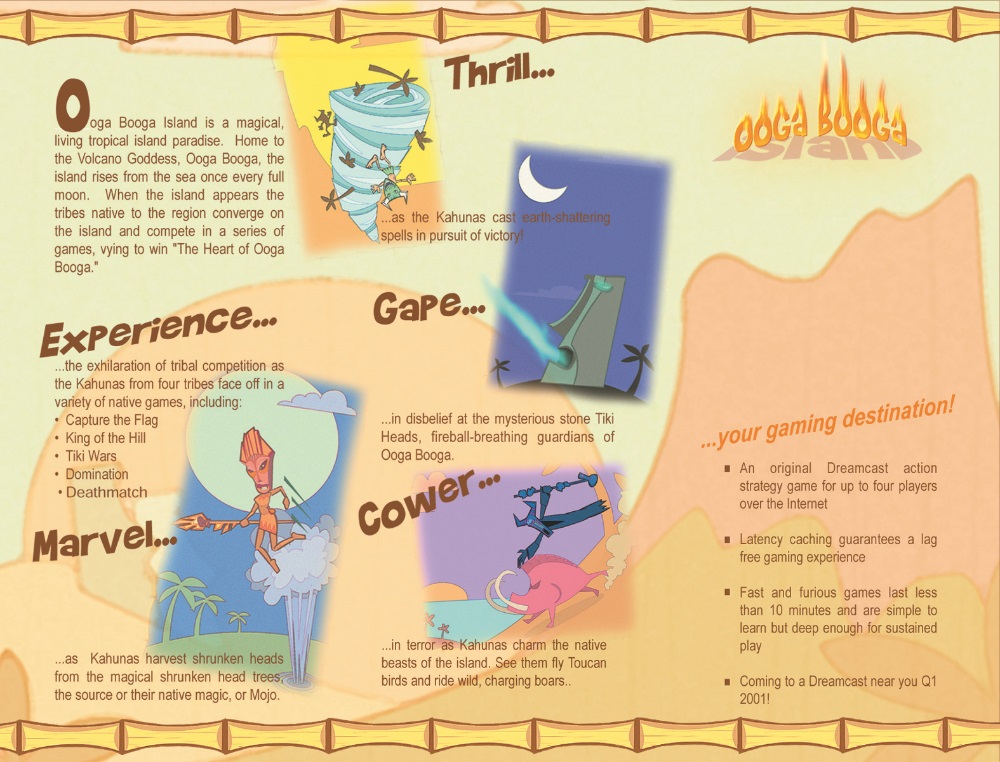
Q: Going off topic a little here but were there any other games Visual Concepts had planned for the Dreamcast that were cancelled due to Sega exiting the hardware business? I’m always intrigued by cancelled games.
“For completely personal reasons I left VC shortly after Ooga so I don’t have a lot of insight into this. We were starting to kick around ideas for another original title, but at that point I don’t think anyone was thinking of Dreamcast. Certainly not for the lead platform.”
Q: One final question. What are the chances of seeing a sequel to Ooga Booga? I know Sega still owns the rights to the IP but maybe a spiritual sequel would be possible if you couldn’t obtain the rights from them?
“Oh god. I wish. I’d love to revisit some of that stuff, if only as a consumer. But I’m so far removed from those discussions. And honestly, given how Ooga performed at retail, I don’t think it has enough of even a cult following for it to make sense. But you never know. I’m sure if there was some sort of resurgence in Ooga awareness and suddenly the audience was there, they would absolutely go for it. Sadly though, I have a hard time imagining that happening.”
A big thanks to John for taking the time to answer the questions for this interview! Ooga Booga is one of my personal favorite Dreamcast games so it’s fascinating to learn more about its origins. Hopefully one day we’ll see a sequel or be able to play the original online once again. If any Sega employees are reading this, bring this up with your boss will ya?

Wow, it’s so good to read this! Ooga Booga is one of my all time favorite games ~~ sometimes I thing just how much I’d like for it to come back. It’s a really fun and silly game
Good to know I’m not the only one who finds this game very unique and fun. =P Reading that brochure it’s interesting to see things mentioned that didn’t make it into the game, such as the Capture the Flag, King of the Hill, Tiki Wars and Domination game types (I assume Deathmatch became Smakahuna). Also, the Tiki is said to be stone, not wood like in the final game. Especially funny to me, since I started collecting and writing down ideas a while back (just for my own entertainment) for what would a sequel be like/play like if I had the chance to make one, and I also had some similar ideas, like Boar Domination, Tiki Domination, Score Domination and Tiki of the Hill game modes. In case anyone is curious about these silly ideas (such as combining spells, new spells, upgrading spells, new Tiki types, achievements etc.), you can read them here: https://www.dropbox.com/sh/colxulsbbkvrnzl/AADLdUQuV4yeO9bqrrRKnYkwa?dl=0
Ooga Booga is a hidden gem for sure! Hopefully this article introduces it to a few new people. P.S. You sure put a lot of time into that sequel concept! Haha! Some cool sounding ideas though.
This makes for a good read
Interesting read 🙂 Well done! Makes me wonder…. If Sega was willing to give AFO server code, why not also give us Ooga Boogas code?
Sega never gave us the AFO server sources. lol The odds of them doing something like that would be just about 0.